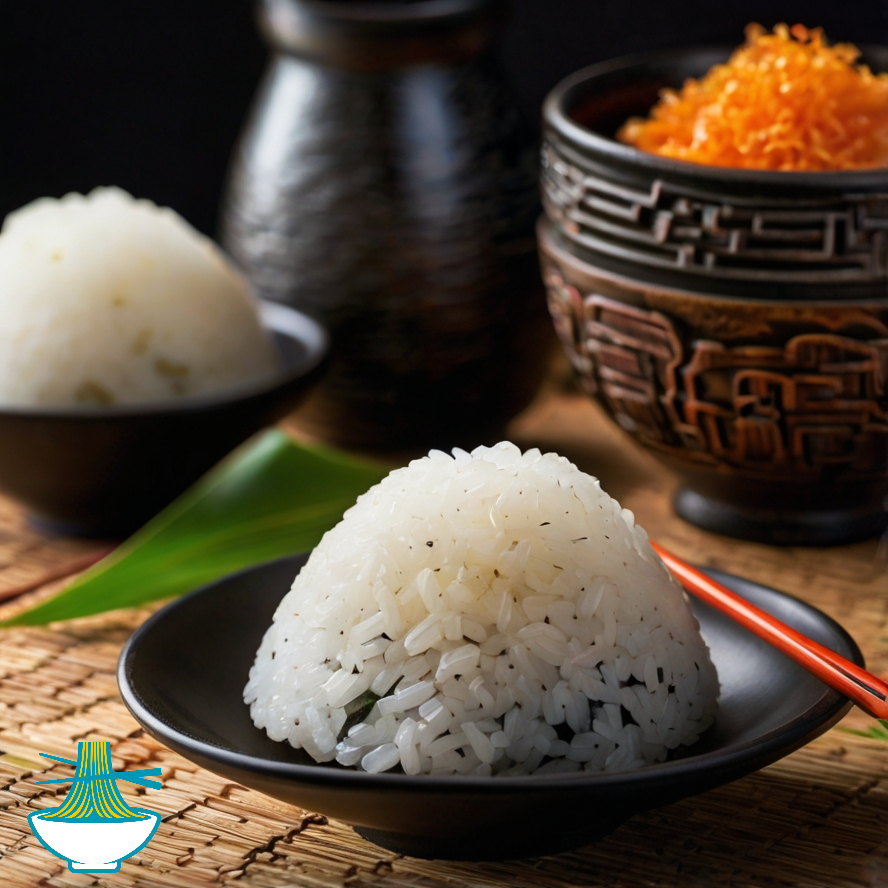Indulge in the iconic flavors of Japan with our meticulously crafted Onigiri, also known as rice balls. Wrapped in nori seaweed and filled with various savory fillings such as tender grilled salmon, tangy pickled plums (umeboshi), or crispy seasoned seaweed (nori), each bite offers a delightful explosion of taste. Perfect for a quick snack, a light meal, or a lunchbox staple, these hand-formed rice balls capture the essence of Japanese culinary heritage. Experience the culinary artistry of Japan with every satisfying bite of our Onigiri.
Ingredients:
- 2 cups sushi rice
- 2 1/2 cups water
- 1/4 cup rice vinegar
- 2 tablespoons sugar
- 1 teaspoon salt
- Nori seaweed sheets (cut into strips)
- Filling options: grilled salmon, pickled plums (umeboshi), seasoned seaweed (nori), tuna mayo, or any other preferred filling

Instructions:
1- Rinse the sushi rice under cold water until the water runs clear. This helps remove excess starch.
2- In a rice cooker or pot, combine the rinsed rice and water. Cook the rice according to the rice cooker's instructions or bring to a boil, then reduce the heat to low, cover, and simmer for about 18-20 minutes, or until the rice is cooked and water is absorbed.
3- In a small saucepan, heat the rice vinegar, sugar, and salt over low heat until the sugar and salt dissolve. Set aside to cool.
4- Once the rice is cooked, transfer it to a large bowl and gently fold in the seasoned vinegar mixture until well combined. Be careful not to mash the rice.
5- Let the rice cool until it's comfortable to handle.
6- Moisten your hands with water to prevent the rice from sticking, then take a small handful of rice and flatten it into a disc shape in the palm of your hand.
7- Place a small amount of your chosen filling in the center of the rice disc.
8- Gently cup your hand and shape the rice around the filling, forming it into a triangular or round ball.
9- If desired, wrap a strip of nori seaweed around the outside of the rice ball, securing it with a dab of water.
10- Repeat the process with the remaining rice and filling.
11- Serve the Onigiri immediately, or wrap each one individually in plastic wrap for later consumption.
Enjoy your homemade Japanese Onigiri! Feel free to experiment with different fillings and shapes to create your own unique variations.
Nutritional Values :
Here's the nutritional breakdown and benefits for the ingredients used in preparing sushi rice and fillings:
Sushi Rice (2 cups dry, ~400g):
- Calories: 1,440 kcal (360 kcal per cup cooked)
- Fat: 0g
- Carbohydrates: 312g (78g per cup cooked)
- Protein: 12g (3g per cup cooked)
Benefits: Provides a primary source of energy through carbohydrates; serves as the base for sushi.
Water (2 1/2 cups):
- Calories:0 kcal
- Fat: 0g
- Carbohydrates: 0g
- Protein: 0g
Benefits: Essential for cooking rice; aids in hydration.
Rice Vinegar (1/4 cup, ~60ml):
- Calories: 10 kcal
- Fat: 0g
- Carbohydrates: 2g
- Protein: 0g
Benefits: Adds flavor and tanginess with minimal calories.
Sugar (2 tablespoons, ~24g):
- Calories: 96 kcal
- Fat: 0g
- Carbohydrates: 24g
- Protein: 0g
Benefits: Provides sweetness to balance the flavor of the sushi rice.
Salt (1 teaspoon, ~6g):
- Calories: 0 kcal
- Fat: 0g
- Carbohydrates: 0g
- Protein: 0g
Benefits: Enhances flavor; essential for seasoning.
Filling Options:
Grilled Salmon (3 oz, ~85g):
- Calories: 206 kcal
- Fat: 12g
- Carbohydrates: 0g
- Protein: 22g
Benefits: High in protein and omega-3 fatty acids, supports heart health and muscle repair.
Pickled Plums (Umeboshi, 2 plums, ~30g):
- Calories:15 kcal
- Fat: 0g
- Carbohydrates: 4g
- Protein: 0g
Benefits: Adds a tangy flavor; rich in antioxidants and can aid digestion.
Seasoned Seaweed (Nori, 1 sheet, ~2g):
- Calories:10 kcal
- Fat: 0g
- Carbohydrates: 1g
- Protein: 1g
Benefits: Adds flavor and nutrients such as iodine and vitamins.
Tuna Mayo (3 oz tuna mixed with 1 tablespoon mayo):
- Calories: 220 kcal
- Fat: 14g
- Carbohydrates: 1g
- Protein: 19g
Benefits: Provides protein and healthy fats; adds creaminess and flavor.
Please note that these values are approximate and can vary based on specific brands, preparation methods, and portion sizes. Additionally, if you choose to use other fillings or variations, the nutritional values may differ.


Comments